
Ref: z263143m
While audio sources at present largely consist of digital media (CDs, DVDs, Internet), most of the audio processing has stayed in the analog domain. It is high time to migrate the audio processing to digital as well.
In the last two decades, audio technology has experienced many advances. Starting 20 years ago with the introduction of the CD, and progressing to MiniDisk and DAT, today we have a choice of high-resolution audio formats such as DVD-Audio, SACD, and the incredible flexibility and storage density of MP3. All these advances concentrate on storage media for the music. But how does the audio signal get processed once it comes off the storage media? How does it get to the output of a system? Are current 'digital' systems truly digital? The vast majority of systems today are not.
In audio/video (A/V)-receivers digital signal processing became popular due to the nature of Dolby digital decoding, but just about all popular audio systems, such as mini-components, car stereos and PC-add on speakers, are still using analog signal-processing technology.
The reason for this is that earlier digital solutions, based on general-purpose digital signal-processors (DSPs), with separate D/A and A/D conversion ICs, carry significant overhead in hardware and programming. Accordingly, the implementation of digital solutions has been difficult and prohibitively expensive.
Now, at a time when major consumer systems are completing the crossover to all-digital media, Analog Devices introduces the AD1954, the first member of the new, cost-effective SigmaDSP family - the first solution to deal directly with the essential problem of integrating an audio-specific DSP, together with high-performance audio converters, on a single IC.
This family of digital sound processing devices, led by the AD1954, offers:
* Professional-quality digital sound processing with integrated converters (112-dB SNR)
* ZERO-hassle programming, along with a highly user-friendly graphical configuration tool
* Very low price, which allows a majority of systems to provide the superior sonic qualities of digital technology.
What is inside the AD1954?
The AD1954 is a pre-programmed, fully configurable digital audio processor. The internal structure is shown in Figure 1.

It is optimised for 2.0 (left/right) and 2.1 (left/right + subwoofer) configurations, and comprises the following processing blocks:
* 3-to-1 digital source selector
* Stereo 7-band equaliser (48-bit double-precision filters)
* Professional-quality dynamic processor (dual-band structure)
* Phat Stereo spatial enhancement
* Delay for speaker location adjustment
* Crossover for independent subwoofer processing
* Volume control
* Three D/A converters (112 dB SNR) for left-, right- and sub-woofer outputs.
All parameters are fully configurable by the system designer. This allows quick design cycle times while permitting full flexibility in adjusting the system to the specific requirements of each market and customer.
Which DSP core is used in a SigmaDSP?
The DSP core used in these products is entirely new - it has been optimised for the requirements of audio processing (Figure 2). Among the features that drastically reduce the cycle count required for it to perform a given audio algorithm are hardware accelerators for double precision and dynamic processing. The DSP core is based on a 26 × 22 multiply-accumulate engine with dual 48-bit accumulators. The input word length is 24 bits, but the core's internal resolution of 26 bits (3.23 format) provides two extra bits for up to +12 dB of gain. Since +12 dB of gain is common in many audio algorithms, no scaling is necessary in most applications.
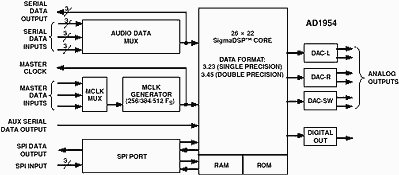
All filters are calculated in 48-bit double-precision resolution, utilising special hardware accelerators. Double precision ensures that low frequency IIR filters can be operated without limit-cycle problems, which cause audible artifacts.
The core memory comprises 2,5 KB of program RAM, 2,5 KB of program ROM and 1 KB of parameter RAM. All memory is directly accessible through the SPI interface, which uses a self-addressing 32-bit format (8-bit address, 24-bit data) that allows single-cycle access to any memory location. The internal clock rate of the AD1954 is 25 MHz - equal to about 50 MIPS of a general-purpose DSP due to the hardware acceleration.
SigmaDSP graphical user interface (GUI) gives the designer total set-up control in real time
SigmaDSP technology is targeted to both the experienced digital designer and the analog designer who knows his audio system well but does not want to dive into the intricacies of low-level DSP programming. Meeting both objectives requires a tool that can be operated intuitively, but provides control of the entire signal flow in realtime.
The solution is the AD1954 graphical user interface (GUI) - shown in Figure 3. It graphically represents the signal flow of the AD1954 and thus its use is truly intuitive. Every parameter in the signal chain, including filter coefficients, volume settings and dynamic processing functions, can be directly accessed and altered in realtime. The GUI connects through the printer port of the PC to the AD1954 evaluation board. In this way, any parametric changes are sent to the AD1954 in SPI format and become immediately effective (in realtime).
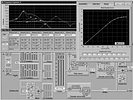
While the SigmaDSP GUI is intended as a dedicated tool for the system designer, it could also be made available (in a modified version) to the enthusiastic end user. With this PC interface, a user can have total control via a notebook PC.
Why is professional-quality dynamic processing so essential?
Small- and medium-size systems, particularly car sound systems, are often limited by their amplifier and speaker power. There are several potential limiting factors: In car systems, the barrier is simply the 12 V supply, which limits the maximum output power to about 20 W r.m.s. into 4 Ω, or 40 W r.m.s. into 2 Ω. In mini-components there is a space constraint on transformer size, and there are thermal constraints. Another factor is speaker equalisation: In small and medium systems, we typically see small cabinets containing small loudspeakers. A popular solution is to use relatively heavy equalisation, particularly in the bass section (bass boost) calling for increased power at low frequencies, to compensate for this acoustically imperfect set-up. Finally (driven by the younger generation), there is a common desire - if not a demand - that these systems have a high maximum volume.
This combination of limited amplifier power, heavy bass equalisation, and significant total loudness of the system leads readily to a situation where the amplifiers are saturated and start to introduce heavy distortion - resulting in an unsatisfactory and annoying listening experience. In the past, attempts to solve this problem typically used primitive clipped-signal detectors, which avoided the clipping but led to artifacts that were nearly as bad as the clipping distortion itself. The professional-quality, dual-band dynamic processors of the AD1954 SigmaDSP make it possible to control the system limits without artifacts.
Increase clarity and loudness of your system
Figures 4 and 5 show an example of a transfer function without any dynamic processing and with a soft knee compressor/limiter function. By using the function shown in Figure 5, the professional-quality dynamic processing of the AD1954 allows natural handling of the clip level, resulting in lower distortion at high volumes. This effectively allows a user to turn up system volume by about 10 dB. 10 dB increase in volume represents doubling the experienced sound pressure level, thus the user can run his system twice as loud.
This is particularly critical in smaller systems with limited amplifier and speaker power.
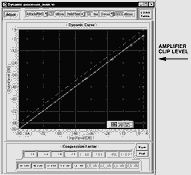
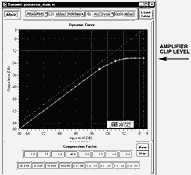
Real-world adjustments
The arbitrarily adjustable transfer function of the SigmaDSP dynamic processors permits many other applications, and the total flexibility allows a user to combine several applications into the same device.
Road-noise compensation: a powerful use of SigmaDSP dynamic processing is in car systems. Besides the sophisticated equalising strategies and distortion handling, it is possible to compensate for the noisy environment of the car interior. While the noise itself cannot be decreased (despite ongoing research projects in active noise cancellation), the only practical way to improve the listening experience is to make soft signals louder. This is especially critical with classical music, where a large dynamic range and many passages of quiet music are common.
With a proper transfer function programmed into the AD1954, signals below a certain threshold can be compressed and the music level can be amplified to maintain a level above the road noise. The ultimate use of this technology can be achieved in OEM car systems, where signals from the speedometer and RPM control signals make it possible for the compensation ratio to be altered depending on the speed (wind noise) and engine RPM (motor noise). Anyone who has experienced a smart road-noise compensation strategy in a car sound system never wants to be without it again (perhaps with the exception of a mid-20th-century Rolls Royce driver.)
Midnight mode: a final example of a special use of the SigmaDSP dynamic processing technology is in the compensation of sudden variations of loudness in movie soundtracks. It seems that, at home, the loudness of the soundtrack - especially in action movies - is just never right (your remote-control finger knows this the best). One reason is that soundtracks are typically mixed for cinemas. In the cinema, the acoustical experience is an essential element of the entire movie experience, and large dynamic variations are a tool that the director uses to generate excitement. In cinemas nobody gets disturbed. At home this is all different. While we still want the movie experience to be as good as possible, we have to avoid waking the children or nearby neighbours.
A 'midnight' mode can handle this annoying problem automatically by reducing the dynamic range of the soundtrack. To implement this feature, a similar transfer function to that used for dynamic clip control is used, but at a much lower threshold. To avoid audible artifacts, a professional-type dual-band dynamic-processor like that implemented in the AD1954 is necessary.
The two pairs of sound tracks (Figure 6) are for voices followed by an action scene (bomb explosion). One can see that, while the dynamic range of the action scene gets reduced when the midnight mode is turned on, the voices stay at the same level.
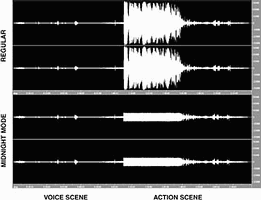
Summary
With the introduction of SigmaDSP technology, the experience of listening to music and movies migrates into a new era. Processing performance, converter technology, and sophisticated algorithms, which have formerly been known only to owners of professional recording studios, are becoming available for cost-sensitive consumer systems. By using SigmaDSP technology, one can develop stereo systems that remain digital until the final output in order to take full advantage of the superb quality of today's digital media.
AD1954
The AD1954 is the first member of ADI's new SigmaDSP family. Evaluation boards and control software are offered. The AD1954 comes in 44-lead MQFP (YS) and 48-lead TQFP (YST) packages, and is rated for the extended temperature range of -40 to 105°C.

© Technews Publishing (Pty) Ltd | All Rights Reserved